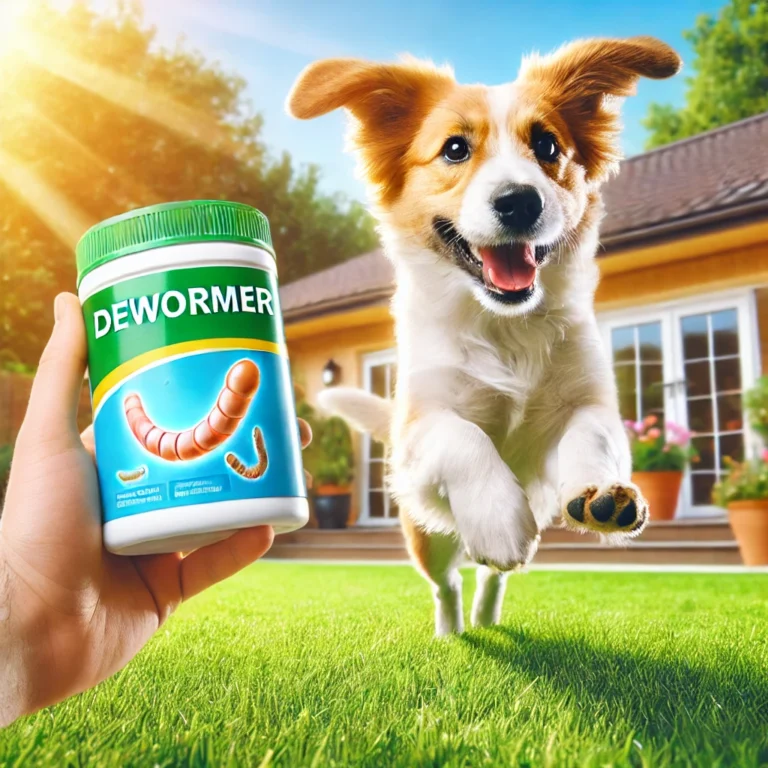
Dealing with your dog’s ear infection without vet can be stressful, but you don’t always need to rush to the vet.
While severe cases may require professional attention, many mild infections can be treated at home using natural remedies.
In this post, we’ll cover 7 proven home remedies to help soothe your dog’s discomfort and promote healing—no vet visit required!
Understanding Dog Ear Infections
Dog ear infections are a common yet frustrating problem for many pet owners.
To effectively treat and prevent these infections, it’s crucial to understand their causes, symptoms, and how they progress.
While certain types of infections can be safely treated at home, others require immediate veterinary attention.
Causes of Dog Ear Infections
Dog ear infections typically arise when moisture, bacteria, or fungi get trapped in the ear canal, leading to inflammation.
Dogs with floppy ears or those who swim frequently are especially prone to infections due to their ears retaining moisture.
Other common causes include:
- Excessive Wax Build-Up: An overproduction of earwax can trap dirt and debris, leading to bacterial growth.
- Allergies: Dogs with food allergies or environmental allergies (such as pollen, mold, or dust) are more susceptible to ear infections. Allergies often cause inflammation in the ear canal, creating an environment where bacteria and yeast thrive.
- Parasites: Ear mites or ticks can irritate the ear canal, causing infections, particularly in puppies or outdoor dogs.
- Foreign Objects: Grass seeds, dirt, or other debris can lodge in your dog’s ear, leading to infection if not promptly removed.
- Underlying Medical Conditions: Conditions like hypothyroidism or autoimmune disorders can make dogs more vulnerable to recurring ear infections.
Understanding the cause of your dog’s ear infection can help you select the right home remedy and prevent future infections.
Symptoms of Dog Ear Infections
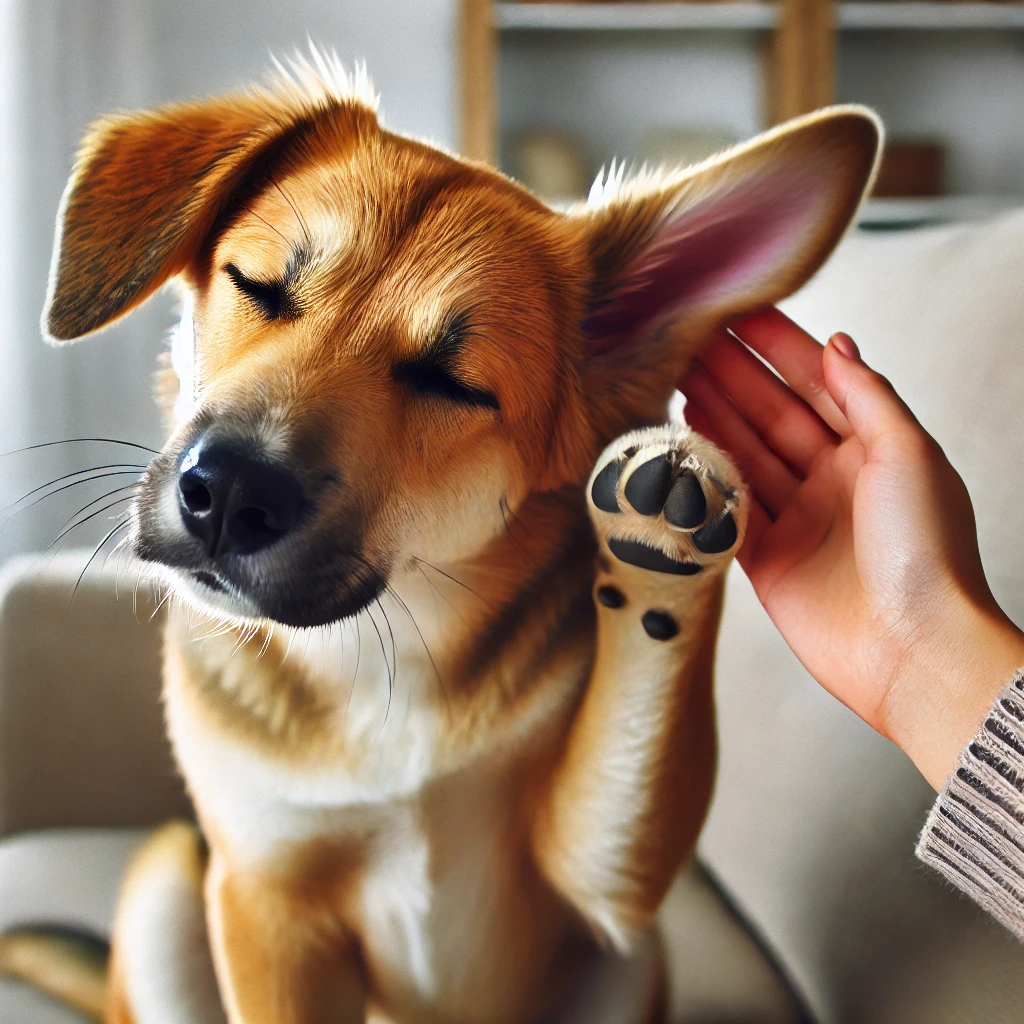
Recognizing the symptoms of an ear infection early on can prevent complications.
Some of the most common symptoms include:
- Frequent Head Shaking or Tilting: If your dog is shaking their head or tilting it to one side more than usual, it’s often a sign that something is irritating their ear canal.
- Scratching or Pawing at the Ears: Persistent scratching around the ears or rubbing their head against furniture or the floor indicates discomfort or itching caused by the infection.
- Redness and Swelling: Look inside your dog’s ears for signs of redness or swelling, which indicate inflammation.
- Odor or Discharge: An ear infection can often be accompanied by a foul smell or discharge that is yellow, brown, or bloody. Discharge typically means there is bacterial or yeast overgrowth.
- Loss of Balance or Hearing: If your dog seems disoriented, is losing balance, or has difficulty hearing, it could indicate that the infection has spread to the middle or inner ear.
In severe cases, untreated ear infections can lead to hearing loss or damage to the ear canal.
This is why it’s essential to monitor these symptoms closely and act promptly.
Types of Ear Infections
Dog ear infections are classified into three types based on the location within the ear:
- Otitis Externa: This is the most common type of ear infection and affects the outer ear canal. It is usually the easiest to treat and is often manageable with home remedies.
- Otitis Media: This infection affects the middle ear and typically results from untreated external ear infections. Otitis media can cause more serious symptoms, including balance issues and discomfort.
- Otitis Interna: The most severe type, otitis interna affects the inner ear and can result in permanent hearing loss, dizziness, or even neurological problems. It often requires medical intervention and antibiotics.
Home remedies are typically effective for mild otitis externa infections.
However, if the infection seems deeper (with symptoms like loss of balance, severe pain, or fever), it’s important to seek veterinary assistance.
Understanding the differences between these types of infections can help you decide whether a home remedy is appropriate or if a vet visit is necessary.

7 Proven Home Remedies for Dog Ear Infections
Here are seven natural remedies you can try at home to relieve your dog’s ear infection.
1. Apple Cider Vinegar and Water Solution
Apple cider vinegar has natural anti-bacterial and anti-fungal properties, making it an effective remedy for dog ear infections.
Instructions:
- Mix equal parts apple cider vinegar and water in a clean bowl.
- Dip a cotton ball or gauze in the solution and gently wipe the inside of your dog’s ear.
- Repeat once a day for up to a week, or until symptoms improve.
Why It Works: Apple cider vinegar helps to clean the ear, reduce inflammation, and fight the bacteria or fungi causing the infection.
Safety Tip: Do not use this remedy if the ear is visibly inflamed or has open sores, as vinegar can sting.
2. Coconut Oil for Soothing Inflammation
Coconut oil is rich in natural anti-inflammatory properties and is safe to apply to your dog’s ears.
Instructions:
- Warm a small amount of organic, unrefined coconut oil until it becomes liquid.
- Using a dropper, place two to three drops of the warm oil into the affected ear.
- Gently massage the base of the ear to help the oil spread.
Why It Works: Coconut oil soothes inflammation and can help fight bacteria and yeast infections.
Safety Tip: Avoid using too much oil, as excessive moisture can worsen the infection.

3. Green Tea for Natural Cleansing
Green tea contains antioxidants that can help reduce inflammation and clear up mild infections.
Instructions:
- Brew a cup of green tea and let it cool to room temperature.
- Use a dropper or clean cloth to apply the tea to the ear canal.
- Gently wipe the ear with a cotton ball to remove any excess.
Why It Works: Green tea has mild astringent properties that help cleanse the ear and reduce swelling.
4. Hydrogen Peroxide Dilution
Hydrogen peroxide can be a great cleanser for dog ears but should be used with caution.
Instructions:
- Mix equal parts hydrogen peroxide and water.
- Dip a cotton ball in the mixture and gently wipe around the ear, avoiding deep insertion.
Why It Works: Hydrogen peroxide helps to break up wax and debris, preventing bacteria from thriving.
Safety Tip: Do not use this remedy if your dog’s ear is already inflamed or if there are open wounds.
5. Calendula Oil as a Healing Agent
Calendula is known for its anti-inflammatory and healing properties.
Instructions:
- Purchase calendula oil from a health store or pharmacy.
- Place two to three drops of the oil in your dog’s ear.
- Gently massage the ear to ensure the oil reaches deep into the canal.
Why It Works: Calendula oil reduces inflammation and promotes healing in the affected area.
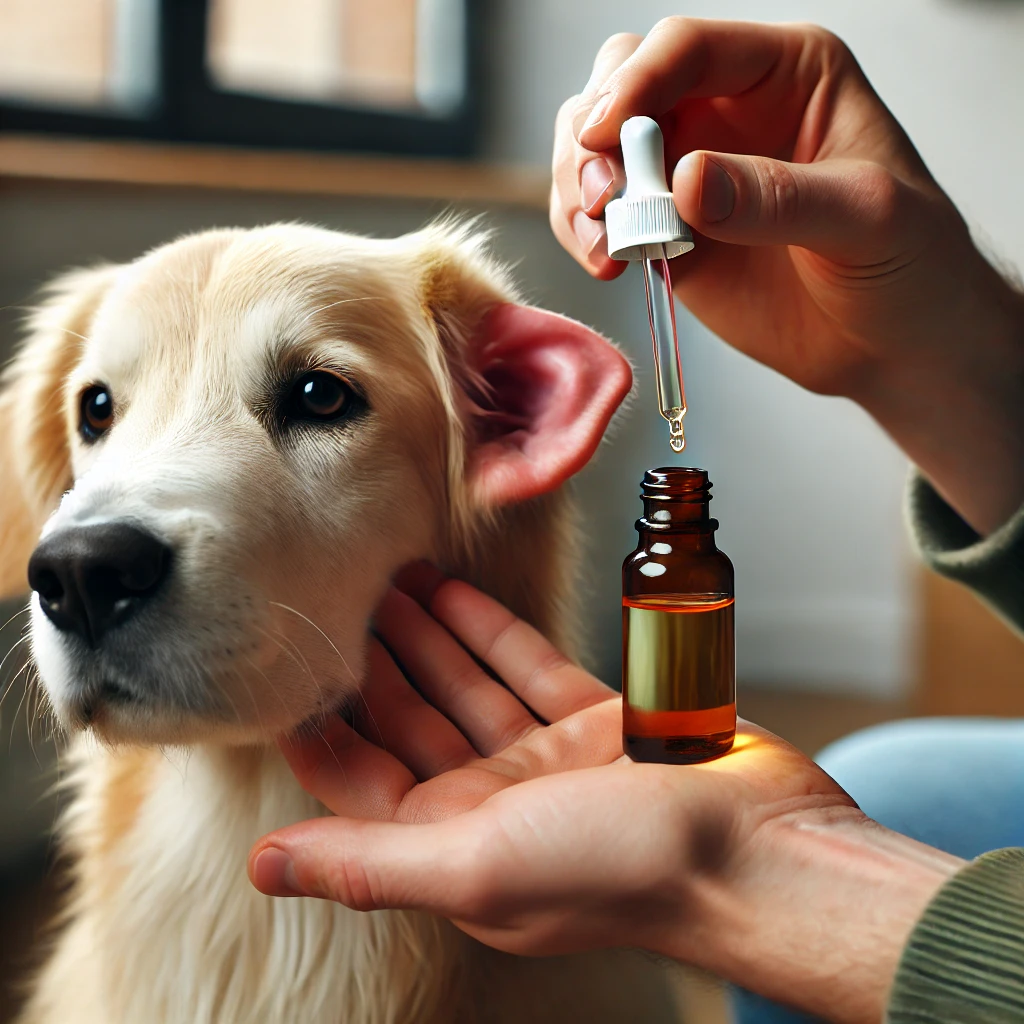
6. Garlic and Olive Oil Infusion
Garlic is a natural antibacterial agent, and when combined with olive oil, it can help relieve symptoms of an ear infection.
Instructions:
- Heat one clove of garlic in two tablespoons of olive oil for 10 minutes.
- Let the oil cool, strain out the garlic, and apply two drops to your dog’s ear.
Why It Works: Garlic’s antibacterial properties work to fight infection, while the olive oil soothes the ear.
Safety Tip: Use this remedy only for mild infections and avoid if the ear is raw or bleeding.
7. Witch Hazel for Gentle Cleansing
Witch hazel is a mild astringent that can help dry out the ear and reduce inflammation.
Instructions:
- Apply a small amount of witch hazel to a cotton ball.
- Gently clean the inside of the ear, avoiding deep insertion.
Why It Works: Witch hazel helps dry out excess moisture, which can prevent the growth of bacteria and yeast.
Additional Tips for Treating Dog Ear Infections at Home
When treating your dog’s ear infection at home, there are several additional steps you can take to ensure effective treatment, prevent recurrence, and keep your dog comfortable.
While the natural remedies mentioned earlier are helpful, proper care and hygiene play a crucial role in successfully managing ear infections.
1. Proper Ear Cleaning
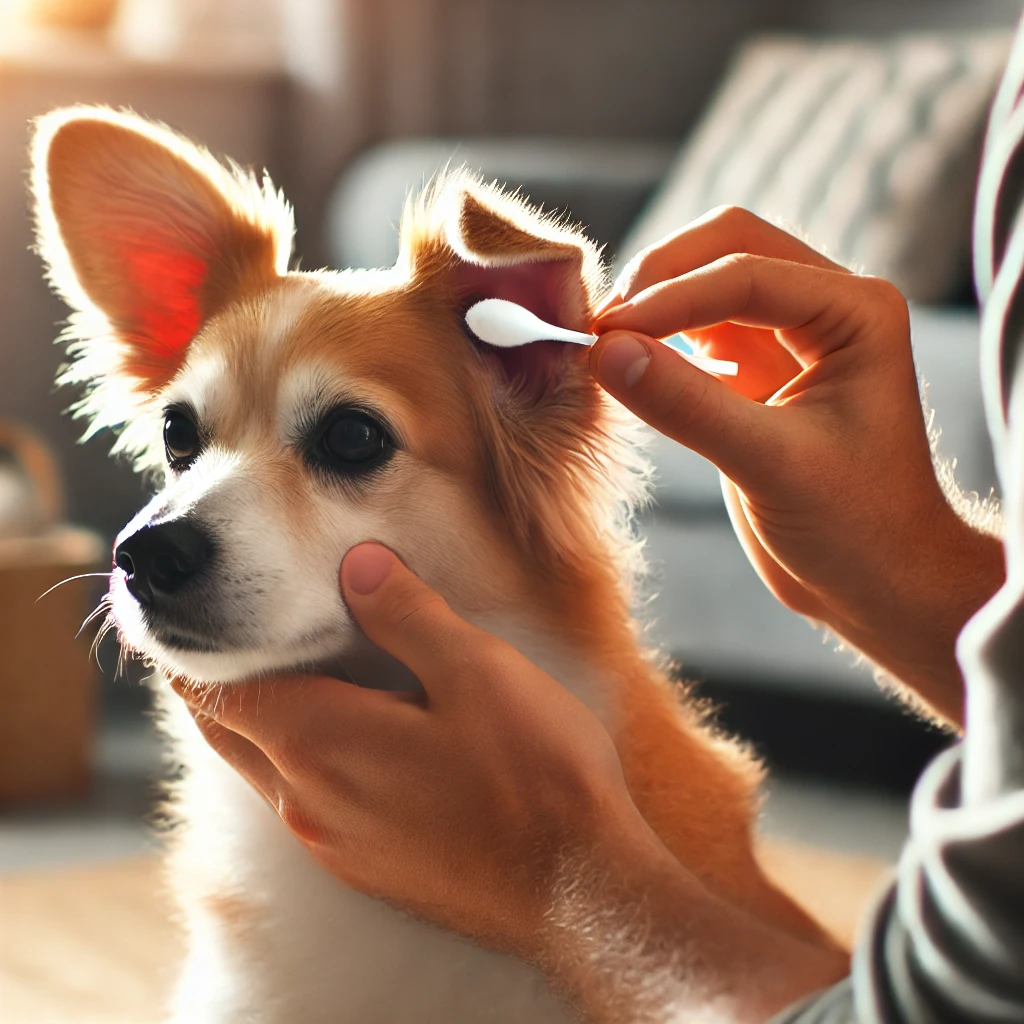
Cleaning your dog’s ears before applying any home remedy is an essential step in the healing process.
Here’s how to safely clean your dog’s ears:
- Use a Vet-Approved Cleaner: Always use a dog-specific ear cleaning solution rather than human products like alcohol or peroxide, which can be too harsh. Look for solutions with gentle, non-irritating ingredients.
- Gentle Cleaning Process:
- Apply the cleaner by gently squirting a few drops into your dog’s ear canal.
- Massage the base of the ear to help the solution break down wax and debris.
- Allow your dog to shake their head to loosen the debris.
- Gently wipe the outer ear with a cotton ball or soft cloth. Avoid using Q-tips as they can push debris further into the ear canal or damage the eardrum.
- Regular Maintenance: Once your dog’s infection clears up, regular ear cleaning can help prevent future infections, especially if your dog has floppy ears or spends a lot of time swimming.
2. Keep Ears Dry

Moisture is a common cause of ear infections, especially for breeds with floppy ears like Cocker Spaniels and Basset Hounds.
To help prevent moisture-related infections:
- Dry Ears After Swimming or Bathing: After your dog swims or has a bath, be sure to thoroughly dry their ears with a clean towel. You can also use a dog-specific ear drying solution to help remove moisture trapped inside the ear canal.
- Use a Hair Dryer (on a Low Setting): For dogs with particularly moist ears, consider using a hair dryer on the lowest setting (and cool air) to help dry out their ears after swimming or bathing. Be careful not to get too close to the ear to avoid causing discomfort.
3. Diet and Supplements for Ear Health
Supporting your dog’s overall health can reduce their risk of developing infections, including ear infections.
Some dietary changes and supplements can strengthen your dog’s immune system and reduce inflammation.
- Consider Adding Omega-3 Fatty Acids: Omega-3s from fish oil are known for their anti-inflammatory properties. Adding a high-quality fish oil supplement to your dog’s diet can help reduce ear inflammation and improve skin health.
- Probiotics for Gut Health: Probiotics can help improve your dog’s digestive system and overall immune response, which in turn may reduce their susceptibility to infections, including ear infections caused by allergies or yeast overgrowth.
- Anti-Allergy Diet: If your dog suffers from recurring ear infections due to allergies, consult your vet about transitioning them to a limited-ingredient or hypoallergenic diet. Food sensitivities (like to chicken or grain) often contribute to chronic ear issues.
4. Monitor Your Dog’s Behavior
During the course of at-home treatment, pay close attention to how your dog is behaving.
Monitoring their symptoms can help you determine if the remedies are working or if it’s time to seek veterinary care.
- Improvement Signs: Reduced scratching, less head shaking, clearer ears, and better overall comfort are signs that the infection is improving.
- Watch for Worsening Symptoms: If your dog’s ear infection isn’t improving within 48 hours of starting home treatment or if their symptoms worsen (such as increased swelling, discharge, or pain), it’s crucial to stop home treatment and visit the vet.
5. Use an Elizabethan Collar (If Necessary)
If your dog is persistently scratching their ears, they may further irritate the infection or even cause open wounds.
In severe cases, using an Elizabethan collar (e-collar) or a soft cone can prevent your dog from scratching and give the infection time to heal.
- E-Collars or Soft Cones: These can be helpful to use temporarily, preventing your dog from making the infection worse by constant pawing at their ears. Many pet stores offer soft cones that are more comfortable for dogs than traditional rigid plastic cones.
6. Monitor for Recurring Infections
If your dog experiences frequent ear infections, it could be a sign of an underlying issue such as allergies, yeast overgrowth, or a weakened immune system. To manage recurring infections:
- Regular Vet Check-Ups: Even if you’re managing the infections at home, it’s important to have your dog checked by a vet if infections keep returning. The vet can help diagnose underlying problems and may suggest long-term treatment options, such as allergy management or ear drops.
- Preventative Ear Care Routine: Set up a routine to clean your dog’s ears once or twice a week to prevent wax and debris buildup. Consistency in ear maintenance can reduce the chances of infection reoccurring, especially in dogs that are predisposed to ear problems.
7. Avoid Over-Cleaning
While keeping your dog’s ears clean is important, over-cleaning can also be harmful.
Cleaning the ears too frequently can strip away natural oils that protect the ear canal, leading to irritation and even increasing the risk of infection.
Limit cleaning to once a week or as recommended by your vet, especially after an infection has been resolved.
By following these additional tips, you’ll not only treat your dog’s ear infection effectively at home but also help prevent future infections, ensuring your dog stays healthy and comfortable.
These simple yet important practices can make a big difference in maintaining your dog’s overall ear health.
When to Consult a Vet
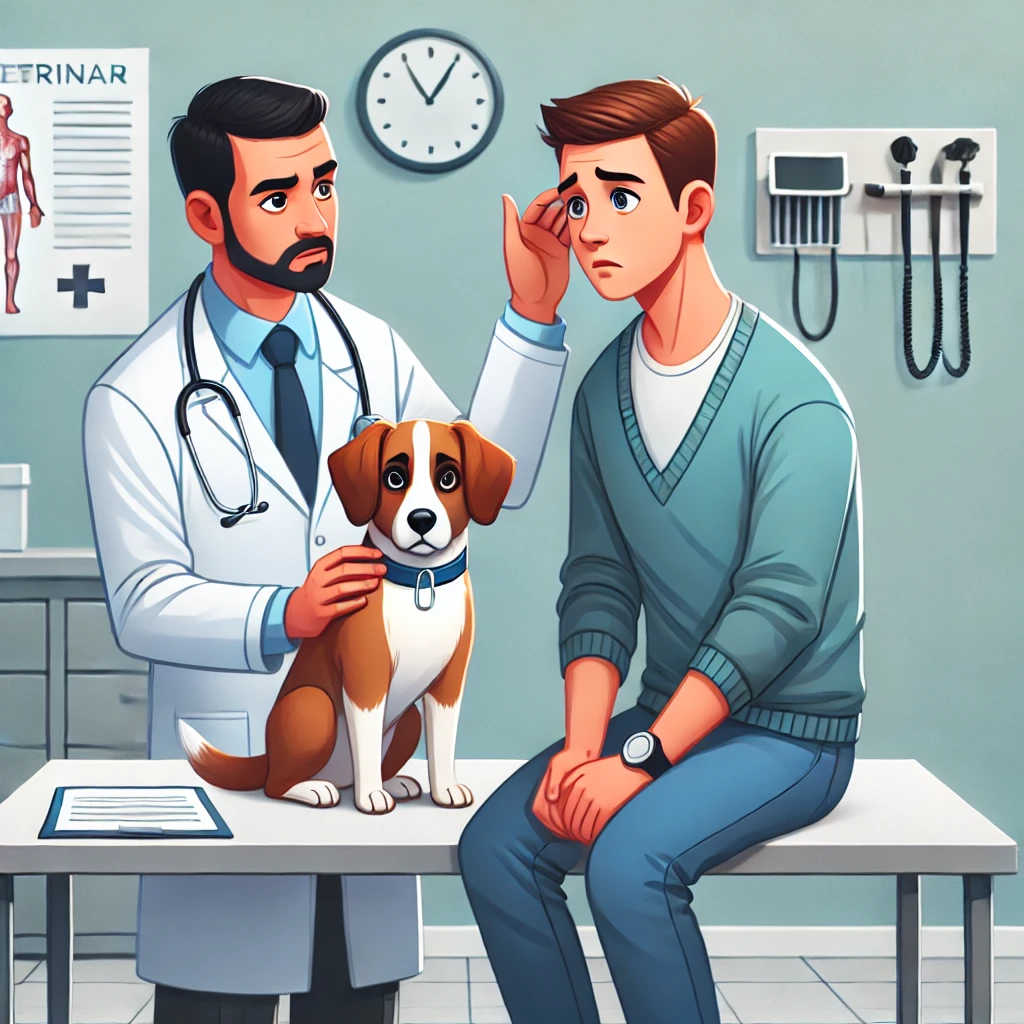
While mild ear infections can often be treated at home using natural remedies, it’s essential to recognize when the situation requires professional veterinary care.
Ear infections that are left untreated or improperly managed can escalate, leading to more serious health issues.
Knowing when to consult a vet can save your dog from unnecessary discomfort and prevent complications such as hearing loss or chronic ear infections.
Below are some clear signs and scenarios that indicate it’s time to seek veterinary assistance.
1. Severe or Persistent Symptoms
If your dog’s symptoms show no signs of improvement after 48 hours of home treatment, or if they worsen, it’s crucial to consult a vet.
Some symptoms that indicate the infection may be more serious than initially thought include:
- Discharge That Is Yellow, Green, or Bloody: While mild wax or clear discharge can be part of the infection, pus-like discharge or blood is a sign of a more severe infection that may require prescription medications, such as antibiotics or antifungal treatments.
- Foul Smell From the Ear: A strong, unpleasant odor coming from your dog’s ear is often a sign of a bacterial or fungal infection. If home remedies don’t eliminate this odor within a couple of days, a vet visit is necessary to determine the cause.
- Severe Redness and Swelling: If your dog’s ear is significantly red or swollen, it could indicate a deep infection or even inflammation of the middle or inner ear, which home remedies won’t be able to treat. This could also signal an allergic reaction or even a foreign object lodged in the ear.
- Intense Pain or Discomfort: If your dog yelps, whines, or reacts aggressively when their ears are touched, this suggests they are in significant pain. Dogs experiencing severe discomfort may refuse to eat or become lethargic. In such cases, a vet is needed to assess and manage the infection properly.
2. Recurring Ear Infections
If your dog is prone to frequent ear infections, it’s time to consult a vet for a more thorough evaluation.
Recurring ear infections are often a sign of an underlying issue such as allergies, chronic yeast infections, or structural abnormalities in the ear. A vet can:
- Identify Underlying Causes: Through diagnostic tests, your vet can determine if the recurrent infections are caused by food allergies, environmental allergens, or other systemic health issues, such as hypothyroidism or immune disorders.
- Provide Long-Term Solutions: If your dog experiences recurrent infections, a vet might recommend specific medications, medicated ear cleaners, or even dietary changes to prevent future infections. In some cases, prescription ear drops with antibiotics or antifungal agents may be required for long-term care.
3. Head Tilting or Balance Issues
If your dog starts tilting their head to one side frequently or seems off-balance, this could indicate that the ear infection has spread from the outer ear to the middle or inner ear (otitis media or otitis interna).
Inner ear infections can affect your dog’s equilibrium and can lead to more serious health issues if not addressed promptly.
Symptoms to watch out for include:
- Frequent Head Tilting: While mild ear infections may cause your dog to shake their head occasionally, persistent tilting of the head (as if they’re trying to relieve pressure) is a more serious symptom.
- Loss of Balance or Disorientation: If your dog seems to lose their balance or walks in circles, it could indicate that the infection has impacted their inner ear, which controls their sense of balance.
- Hearing Loss: If you notice that your dog is not responding to your voice or other sounds as usual, an inner ear infection could be impairing their hearing. This requires immediate veterinary attention to prevent permanent damage.
4. Signs of a Systemic Infection
Ear infections that are left untreated or that spread deeper into the ear can lead to systemic infections that affect the rest of your dog’s body.
These signs often indicate that the infection has progressed beyond the ear canal and is affecting other areas:
- Fever: If your dog’s body temperature rises above the normal range (typically between 101 and 102.5°F), this could be a sign that the infection is spreading, and it’s important to seek immediate veterinary care.
- Lethargy or Loss of Appetite: If your dog becomes unusually tired, lethargic, or loses interest in food, it could be a sign that the infection is causing more widespread illness. Dogs in pain or discomfort may also hide, avoid interaction, or become withdrawn.
- Swollen Lymph Nodes: If you notice swelling around your dog’s jaw, neck, or ears, it could indicate that the infection has spread to their lymph nodes, suggesting the body is fighting off a more severe infection.
5. Open Sores or Wounds
If your dog has scratched or pawed at their ear to the point of causing open sores or wounds, it’s time to see a vet.
Open wounds can easily become infected with bacteria, leading to a worsening of the ear infection or even a secondary infection that may require antibiotics.
A vet can help treat the wounds while also addressing the underlying ear infection.
6. Chronic Ear Issues in Certain Breeds
Certain dog breeds are more prone to chronic ear infections due to the structure of their ears.
Breeds with floppy ears, such as Cocker Spaniels, Basset Hounds, and Golden Retrievers, or dogs with narrow ear canals like Bulldogs, are more susceptible to ear infections because their ears trap moisture and debris more easily.
If you have one of these breeds and notice frequent infections, your vet can recommend a preventive ear care routine tailored to your dog’s specific needs.
This may involve regular ear cleaning, the use of prescription-strength ear drops, or changes in diet to reduce inflammation.
7. No Response to Home Remedies
If you’ve been diligently applying home remedies such as apple cider vinegar, coconut oil, or herbal treatments, but your dog’s condition isn’t improving or has worsened, it’s a clear signal that the infection may require prescription medication.
Natural treatments are generally effective for mild infections, but bacterial or fungal infections can sometimes be too severe for home remedies alone to manage.
Why Timely Veterinary Care Is Important
Delaying treatment for a dog’s ear infection can lead to more serious complications, such as permanent damage to the ear canal, chronic infections, or even neurological issues if the inner ear is affected.
In some cases, untreated infections can spread to the bloodstream, leading to potentially life-threatening conditions like sepsis.
Consulting a vet early on, especially when symptoms worsen or persist, ensures that your dog gets the right treatment in time to avoid long-term health issues.
If you’re unsure whether your dog’s ear infection requires a vet visit, it’s always better to err on the side of caution.
Your vet can provide the best course of action to protect your dog’s health and comfort.
By staying proactive and recognizing the signs that your dog needs professional care, you can help prevent complications and ensure a quicker recovery.

Conclusion – How to Treat Dog Ear Infection Without Vet
Most mild dog ear infections can be treated at home using natural remedies, such as apple cider vinegar, coconut oil, or garlic-infused olive oil.
However, always monitor your dog’s condition closely and be sure to consult your vet if the infection does not improve.
With these safe, simple remedies, you can help your dog feel more comfortable and get back to their playful self in no time.
FAQs
1. Can I use these remedies on puppies?
Yes, but be gentle, and start with very mild solutions, like coconut oil or calendula oil.
2. How long should I try these remedies before seeing results?
You should see improvement within 24–48 hours. If the infection persists, consult a vet.
3. Is it safe to use these remedies for other pets?
Always consult your vet before applying any remedy to other pets, as their ear structure may differ from dogs.
Related Articles:
Dewormer for Dogs: The Ultimate Guide to Keep Your Pup Parasite-Free!



